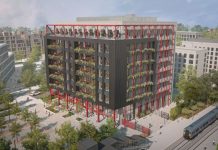The South Bristol Link Road has the potential to drive prosperity and investment across the whole of the city, says leading property advisers Jones Lang LaSalle.
Jeremy Richards, head of the Bristol office, says: “It is clear that South Bristol has suffered as a result of poor infrastructure and lack of accessibility, and the South Bristol Link Road is an essential part of tackling the problem.”
Much of Bristol’s expansion and prosperity arose from the arrival of the M4 and M5 in the 1970s, which played a major role in opening up the northern and western parts of the city to investment. The M48/M49 followed in the 1990s, and Bristol has had little else since.
Jeremy said: “South Bristol in particular is woefully lacking in infrastructure and it’s no coincidence that the south of the city is viewed as the ‘poor relation’ of the north when it comes to business investment.
“We know from speaking to businesses in the city that south Bristol looks great on paper, but when they visit, it doesn’t have the connectivity that they require so they go elsewhere. We have numerous examples of companies that have sited the lack of accessibility as the key reason for not moving to the south of the city.
“The area has suffered during the recession and there have been several national businesses that have moved away, partly because of the lack of good access to their premises. This is particularly problematic for industrial businesses which require a good road network for larger vehicles.
“But it’s not just the national players that are being affected. South Bristol is a locally driven market and we hear the same feedback from SMEs in the area. As a result, the amount of empty space in industrial units is worryingly high, and is now at a similar level to what it was at the peak of the recession.
“We have a chance to change all of this. We should be embracing the concept of major infrastructure to bring similar benefits to those enjoyed by other parts of the city, and the South Bristol Link Road is a crucial part of this. It must of course meet the transport needs of a wide variety of road-users, not just the car driver. Bus and cycle lanes and other sustainable transport options are central to the plans to ensure accessibility is open to all.”
Jones Lang LaSalle believes the benefits will be felt right across Bristol and the wider region.
“The ripple effect is significant,” says Jeremy.
“It’s not just about the estimated 5,600 new jobs that the project is expected to help create. There’s a much bigger story to tell about the wider regeneration which it will help kickstart. New employment brings new development of all sorts – homes, shops, restaurants – and the positive impact of all this should not be underestimated.
Of course, as with any major development, there are winners and losers and unfortunately it will affect those who live around it. But the economic and business case for the Link Road far outweighs the negatives.
“History shows that where infrastructure goes, prosperity follows and there’s no doubt that if the motorway network had run to the south of Bristol rather than the north, the city may have witnessed a reversal of fortune.
“Certainly, if planners were tasked with designing the city from scratch, it is unlikely that they would allow such an infrastructure ‘blackspot’ in south Bristol. This project has the potential to complete this missing link which, as we come out of recession, is needed now more than ever.”



















